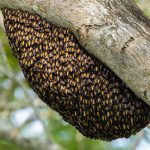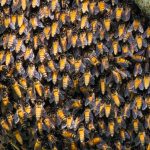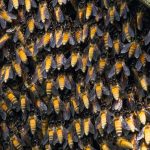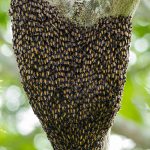When we normally talk about enjoying the great outdoors in Singapore, the general public assessment of risk typically include fear of snake bites, or ferocious wild boars running loose. Some will fear wild dogs, and others will fear spiders, scorpions and other creepy crawlies. While some of these are undoubtedly dangerous if handled incorrectly, thankfully for the past few years, there have been no fatalities involving any of these animals.
There is however one exception. Giant Honey Bees have been responsible for the unfortunate death of a Singaporean pest control officer1 (link) in November 2013.
The Giant Honey Bees (Apis dorsata) is a honey bee common in South Asia and South-East Asia. These bees migrate seasonally. They nest in the open on tree branches or trunks and even on balcony of buildings2 (link). There is much to fear about them. Unlike their more docile cousins the European or Asiatic Honey Bee, they are rather ferocious especially near their nest or provoked, and will collectively swarm their target causing multiple potentially fatal stings3 (link). Killing of a single bee will cause pheromones to be released signalling further aggression. In other words, when you spot them, getting away will be the wisest decision.
Having said that, human have been gathering honey and beeswax from these bee colonies since ancient times and have developed techniques to avoid getting stung. Chief among these is the use of smoke to calm the bees. It is fascinating to read and see these honey hunters4 (link) and 5 (link) in action. Nonetheless, we would be ill advised to try to emulate what they do when we come across these bees.
In the late afternoon of June 2011, I stumbled upon a nest of these Giant Honey Bees at Pasir Ris Park. Not aware of their ferocious reputation as I assumed they were normal honey bees, I stayed around to take some photos and videos of the bee nest. Even then, I did not go near the nest. I remembered vividly being stung by bees a few times in my younger days and knew enough not to provoke them.
The nest formed on the trunk of a tree and must have been around 2 to 3 metres off the ground. This was not typical of their nesting sites, which normally are high up on tall trees. Nearby, most people were not aware of the presence of these bees and went about doing their things. Thankfully that patch of ground was slightly off the walking track. I don’t recall any untoward incident or reports of their presence at the park.
A few days later, I returned to the same place but they were not around anymore. Perhaps the lack of suitable flowers/food at the location prompted them to move elsewhere.
Below are the photos and video of the bee nest.
Video
Photo Gallery
References:
1. Death of man stung by bees ruled accidental
2. Video of Giant Honey Bees nest on building in Bangalore
3. Giant honey bees – Life in the Undergrowth – BBC Attenborough
4. A honey-collecting odyssey – BBC
5. Video of Harvesting honey of Giant Honey Bees in Bangalore




